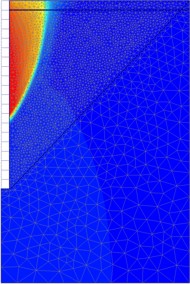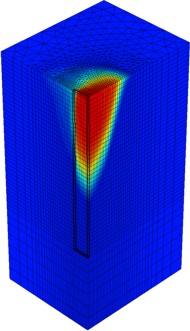skip to content
back to top
 Investigation of the instalation process of a diaphragm wall trench
Investigation of the instalation process of a diaphragm wall trench
|
|
Customer:
Institute of Geotechnical Engineering, University of Stuttgart
Subsoil:
Man-made fills, holocene clay- and peat layers as well as pleistocene sand and pleistocene layers of sand, loam, clay and peat.
Scope of work:
- Three-dimensional Finite Element analyses on the deformation during instalation of a diaphragm wall trench
- Investigation on the influence of different approaches for the fresh concrete pressure
- Comparative analyses on the stability of a diaphragm wall trench (two-dimensional (plane strain), axisymmetric and three-dimensional Finite Element analyses)
Used Finite Element Code:
PLAXIS 2D V8.4
PLAXIS 3D Foundations V2.1
Used constitutive laws:
Linear elasticity (generalized Hooke)
Hardening-Soil model (elasto-plastic)
Model size:
| 2D model for Phi-c reduction: 40 m x 60 m 6.099 triangular elements with quadratic interpolation 12.376 nodes |
3D model for Phi-c reduction: 25 m x 30 m x 60 m 62.100 wedge elements with quadratic interpolation 164.500 nodes |


